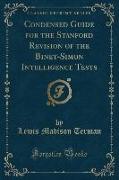- Start
- Condensed Guide for the Stanford Revision of the Binet-Simon Intelligence Tests (Classic Reprint)
Condensed Guide for the Stanford Revision of the Binet-Simon Intelligence Tests (Classic Reprint)
Angebote / Angebote:
Excerpt from Condensed Guide for the Stanford Revision of the Binet-Simon Intelligence Tests
The Binet-Simon tests had been in use in America for only a few years when their educational value for the blind was recognized by Mr. R. B. Irwin, then Supervisor of the Department for the Blind in the Cleveland public schools. In the summer of 1914 he visited Dr. H. H. Goddard at Vineland, N. J., to discuss the question of adapting them for use with pupils without vision. Taking Goddard's translation of the 1911 edition of the Binet scale as a basis, they struck out those tests which could not be given without the aid of vision, made additions from various sources, and arranged the whole collection of tests in year groups according to Irwin's judgment of the abilities of blind children. In collaboration with Dr. Goddard, Dr. E. A. Doll and Miss Elisabeth S. Kite of Vineland, Irwin was able, during the succeeding year, to have these tests tried out in various homes for blind babies, in residential schools for the blind, and in classes for the blind and the partially-seeing in the public schools.
In 1915, Irwin arranged to have Dr. T. H. Haines test the pupils of the Ohio State School for the Blind, and in 1916, Haines published a report upon his use of the year scale and presented a revision of the Yerkes Point Scale adapted to the blind. During the same period, Dr. W. B. Drummond was testing pupils in various schools for the blind in England and Scotland, and in 1920 he published a Binet Scale for the Blind and a Provisional Point Scale for the Blind, building upon the work of Irwin and Haines.
Systematic routine testing with Irwin's adaptation had also been started in 1916 by Miss Edith M. Taylor at Perkins Institution for the Blind in Watertown, Massachusetts, and by Miss Katherine Roese at the Pennsylvania Institution for the Instruction of the Blind in Overbrook, Philadelphia. During the next few years all the pupils in eight other residential schools were tested, so that by the end of 1922 the Irwin adaptation had been given to more than 1, 600 subjects with defective vision. The data thus accumulated seemed to justify an attempt to standardize the tests and to distribute a Guide for the use of competent persons in schools and clinics, where it might be necessary to examine children who had not vision enough to take the Binet tests in their ordinary form.
About the Publisher
Forgotten Books publishes hundreds of thousands of rare and classic books. Find more at www.forgottenbooks.com
This book is a reproduction of an important historical work. Forgotten Books uses state-of-the-art technology to digitally reconstruct the work, preserving the original format whilst repairing imperfections present in the aged copy. In rare cases, an imperfection in the original, such as a blemish or missing page, may be replicated in our edition. We do, however, repair the vast majority of imperfections successfully, any imperfections that remain are intentionally left to preserve the state of such historical works.
Folgt in ca. 5 Arbeitstagen
